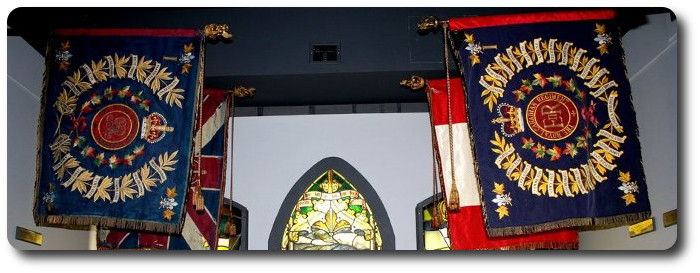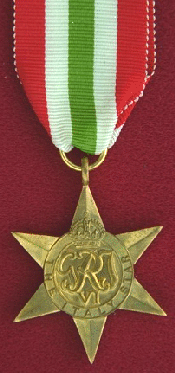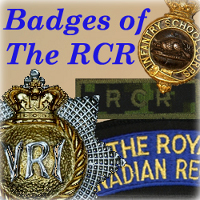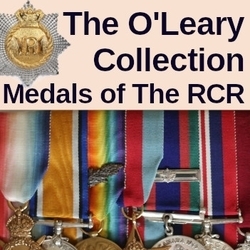
Researching The Royal Canadian Regiment
Ortona Crossroads – Italy
The Connecting File, October 1947

The Italy Star was awarded for one day operational service in Sicily or Italy between 11 June 1943 and 08 May 1945.
13 Dec., 1943; Area, "Slaughterhouse Hill"
At this point, 1 C.I.B. was in semi-active rest, while the Division endeavoured to push toward Ortona with 2 and 3 C.I.B. The forward picture was obscure except that the two Brigades were making little progress, faced by last ditch stand of the 90th Panzer Grenadier Division in an almost perfect defensive position. It was during this fighting that Capt. P. Triquet of the Royal 22nd Regiment so distinguished himself at Casa Berardi that he was later awarded the Victoria Cross.
Semi-active rest as we understood it (approximately 25 all ranks per platoon) to do the occasional patrol; man three section posts, that aggravating but necessary drill of stand to ; digging; plus the many administrative duties, which following such an action as "The Moro Crossing" always raised their ugly heads; with of course enemy shelling, mortar fire, and the odd long Machine Gun burst as a constant reminder that the Tedesci were still neighborly. It was now known that the 1st German Parachute Division had relieved the 90th Panzers.
The Nebelwerfer or "Moaning Minnie," their multiple mortar, also made our acquaintance for the first time.
While here word was received that Capt. G.C. Dinwiddie (ex P.F. "B" Coy.) and Capt J.B. Hunt (Comd. "B" Coy at Campobasso) were both killed in action while posted to other units, the former while serving with the H. & PER, the latter with the PPCLL 16 Dec., '43
Major W.W. Mathers assumed command vice Lt.-Col. D.C. Spry, who became commander of 1 C.I.B.
1st Division now planned to cut the road from the Ortona Crossroads to Villa Grande. Two Bns. were slated for the actual assault, the 48th Highlanders and the Royal Canadian Regiment, both to be supported by armour and a mass of artillery; nine Field Regiments; three Medium Regiments.
This attack from the left flank of the Division went in at 0820 hrs. with terrific artillery support. (One report stated that the field guns alone, used some 100,000 rounds before and during the barrage.)
The first wave of the assault (the 48th Highlanders) was successful in reaching its objective. Following this, the Regiment crossed the start line with two Coys., "D" (Lithgow) right, "C" (Nelson) left.
Almost immediately they met terrific mortar, shell, and machine gun fire. Casualties were very heavy.
The supporting Armour (see Note 1) gave every possible assistance but wireless intercommunication with Infantry failed. Cover was such that it was excellent for the defender, but no help to the attacker, just sufficient for the tank with its limited vision to doubt friend from foe. Such confused fighting necessitated a direct practical means for the section leader to liaise with the tank, but none existed.
In the next hour, much heavy close-quarter fighting went on; the gullies were alive with snipers and the murderous cross-fire of machine guns; all officers in "C" and "D" Coys. were dead or wounded; the barrage was so close to .Canadian troops in the Berardi area that it was lifted too quickly for the advancing Coys. to keep up, and the Armour became separated from the Infantry.
The Commanding Officer then decided to group the Battalion in a firm base position around Farm Buildings, later called Snipers Roost.
Several groups were out of contact and did NOT regain the Battalion fold until the following day. Of these, one was commanded by Cpl. (now Lieut.) C. G. Forrest, who was awarded the DCM for outstanding conduct during this phase. (The reader will recall his citation, July Connecting File.)
Most of the sub-unit Commanders had gone down:
- Major E. G. Nelson, Coy. Comd., killed. . .
- Lieut. M. Sterlin, Pl. Comd., killed.
- Lieut. R. H. Dougles, Pl. Comd., killed.
- Sgt. C. Sherrard, Pl. Comd., killed.
- CSM W. T. Byrne, killed.
- Capt. C. Lithrow, Coy. Comd., wounded.
- Sgt. E. G. Richardson, PI.- Comd., wounded.
- Lieut. R. B. Robertson, PI. Comd., wounded.
- CSM R. W. Menzies, wounded.
The Regiment held firm until the following day, patrolling, reorganizing, in preparation to continue the assault. As the Unit strength was 18 officers and 159 other ranks, C and D Coys. were combined with 4 Platoon to form one Coy.
Sniper action wounded two more officers: the C.O., Major W.W. Mathers, and Lieut. G.K. Wright. Major I.A. Hodson now assumed command of the Unit
19 Dec., 1943 - 1445 hrs.
The Regiment once again, crossed the start line bound for the Crossroads. The plan called for an assault on a one Coy. front, "B" closely followed by "A", supported by Artillery and Armour. The remaining Coy., Command Group, and remnants of "S" Coy. were to move up on call.
The God of War smiled; everything clicked; the element of luck was in our favour, and the attacking force moved as one. The' scene as visualized from the Italian Observation point was a precision set-piece attack. First the terrific curtain of Artillery fire; leaning into it was "B" Coy’s first platoon commanded by Lieut. F. J. Sims; remainder of "B" Coy. (Wildfang) closely followed by "A" Coy. (Dillon); with our Armour (see Note 2) in and around the two Coys. spitting small arms fire.
In this order both Coys' moved on to the objective with little trouble and few casualties (see Note 3). A great. feeling of triumph assailed us; the Orton a Crossroads were at last in our hands.
Without the barrage, the remainder of the Battalion had considerable difficulty in closing tip; This was finally completed after dark, approximately 2100 hours. "A" and "B" Coys. then commenced to relax and breath more freely.
The following day Major A. S. A. Galloway assumed Comd., as the previous C.O. had been evacuated.
We remained in this area for two days. Enemy fire was active, but all ranks made full use of the brief stop-over. Reorganization was carried out, Major R.G. Liddel was appointed 2 i/c, and the four rifle Coys. set up was reinstituted under:
- A Coy – Capt. R.M. Dillon, MC.
- B Coy – Capt. T.H. Burdett.
- C Coy – Capt. M. Upper. (Att. R.H.L.I.)
- D Coy – Capt. J.B. Smith.
It was a heart-rending sight to all ranks to-watch 2 C.I.B. picking their way through our positions enroute to Ortona proper.
Considerable patrolling and some house clearing was carried out. The two most important patrols were commanded by Lieut. Bowman, MC, and Lieut. Wildfang, this being the second very active patrol for the latter officer in three days.
It was rather fitting that while in this position, following three weeks of the most desperate fighting to date, that the Regiment observed its 60th Birthday. Those officers who could be spared from their positions gathered at the Command Post where the Brigade Commander, Lt.-Col. D.C. Spry, spoke on the future of the Royal Canadian Regiment.
Notes
1. This was the first action during which an officer of the Regiment had ridden in a tank to act as a Liaison Officer between tanks and Infantry. This officer was Lieut. A.W. Roy, the Battalion Intelligence Officer.
2. Major A.S.A. Galloway, "B" Coy Commander, rode in a tank as force commander to knit both Armour and Assaulting Infantry as closely as possible.
3. Old "B" Coy. HQ will remember CSM (later Capt.) E. G. Lewington's tender feelings on this point.


